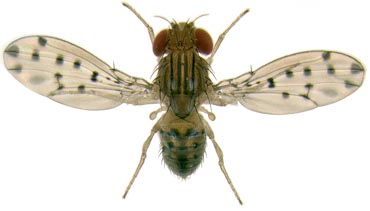Controls for animals’ color designs revealed
The vivid colors and designs animals use to interact with their environments have awed and inspired since before people learned to draw on the cave wall.

The vivid colors and designs animals use to interact with their environments is one of nature’s wonders. But how they build those designs from scratch and deploy color has also been one of nature’s most closely held secrets. This North American fruit fly, Drosophila guttifera, has now helped a team of scientists in the laboratory of UW–Madison molecular biologist Sean Carroll figure out how complex color patterns are made at the most basic level.
Photo: provided by Nicolas Gompel and Sean Carroll
But how different creatures in the animal kingdom — from colorful birds and reef fish to butterflies and snakes — make and deploy their artful designs is one of nature’s deepest secrets. Now, however, a team of researchers from the Howard Hughes Medical Institute at UW–Madison has exposed the fine details of how animals make new body ornamentation from scratch. The work, the result of years-long and laborious experimentation, is published today (Wednesday, April 7) in the journal Nature.
“How do you generate complex patterns? This is a question that has interested biologists for a really long time,” says Sean Carroll, a UW–Madison molecular biologist and the senior author of the Nature report. “In this case, we at first had no clue. But now we think we’ve figured out all the key ingredients and we believe they are generally applicable (to many animals).”
The new study is important because it is the first to provide concrete evidence for a long-hypothesized system for generating animal color patterns, be they stripes, spots or any of the myriad designs animals use to camouflage themselves or find a mate. In particular, the Wisconsin group is the first to identify a color-inducing morphogen, a diffusible protein that tells certain cells to make pigment.
To ferret out the secret of animal ornamentation, Carroll and his UW–Madison colleagues, Thomas Werner and Shigeyuki Koshikawa, and Thomas Williams, now at the University of Dayton, pried loose the molecular details and evolutionary history of how a species of North American fruit fly, Drosophila guttifera, generates a complex pattern of 16 wing spots.
The group discovered a morphogen, a protein present in embryonic tissue and encoded by a gene known as Wingless, which seems to be a linchpin of wing decoration. Late in wing development, the Wingless morphogen is produced and diffuses through tissue where it prompts cells in certain areas of the wing to make pigment. “It acts by triggering responding cells to do things, in this case make color,” Carroll explains.
In Drosophila guttifera, the morphogen acts in proximity to existing physical landmarks such as the intersections of veins and cross veins on the wing. The positioning of the spots, in short, is dictated by these pre-existing patterns, notes Carroll: “The Wingless molecule is deployed in this species at specific points in time and in specific places — the places where the spots are going to be.”
The role of the Wingless morphogen was detailed by the painstaking genetic manipulation of flies that took three years and the injection of nearly 20,000 fly embryos to accomplish. Complicating the project is the fact that Drosophila guttifera is little used in research and its genome has not been sequenced.
However, by inserting the Wingless gene into different parts of the fly’s genome, the team was able to successfully manipulate the decoration of the fly’s wing, creating stripes instead of spots, and patterns not seen in nature. “We can make custom flies,” notes Carroll. By manipulating the gene, “we can make striped flies out of spotted flies.”
In addition to working out the molecular details of how the fly colors its wings, Carroll’s group was also able to deduce the evolutionary history of wing coloring in Drosophila guttifera.
In short, says Carroll, the patterns found on the wings of Drosophila guttifera came about through the fly’s manipulation of the Wingless gene: “It evolved by simply turning this gene on in places where it hadn’t been on before.”
Although the study was conducted in a lowly fruit fly, the principles uncovered by Carroll’s group, he argues, very likely apply to many animals, everything from butterflies to boa constrictors. “This is animal color patterning, how they are generated, how they evolved.”
Tags: biosciences, research



